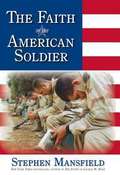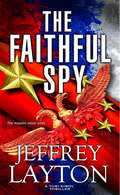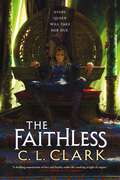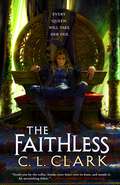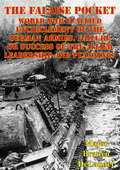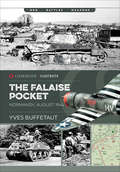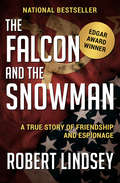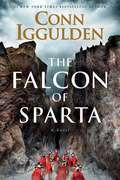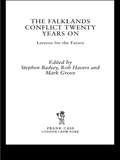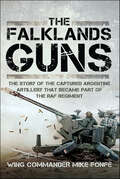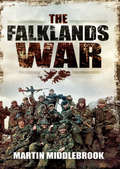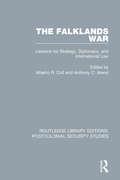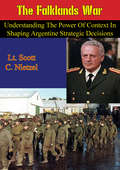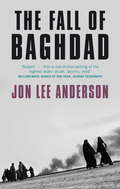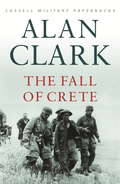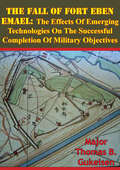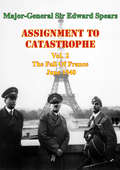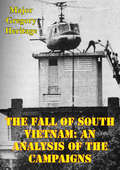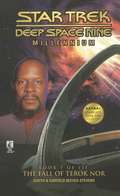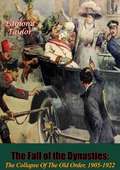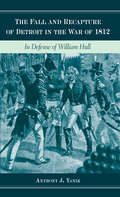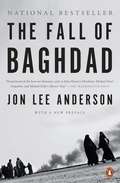- Table View
- List View
The Faith of the American Soldier
by Stephen MansfieldWhat goes through the mind of an American warrior spiritually and religiously when facing the enemy? Touching on a subject that few books have treated, The Faith of the American Soldier examines the religious and spiritual issues in America's wars, and then considers what is lost to our military through a secular approach to battle. Stephen Mansfield, author of The Faith of George W. Bush, a New York Times bestseller, records the refelctionsand testimonies of men and women who have fought on the front lines from Lexington to Iraq. "This book is the product of a search for the meaning of the American warrior code and the faith that gave it birth," Mansfield writes. " A nation's warrior code is an extension of its soul, the embodiment of its highest ideals. "
The Faithful Spy (A Yuri Kirov Thriller #3)
by Jeffrey LaytonA spy without a country . . . Yuri Kirov is a wanted man. A former intelligence officer for the Russian Navy, he is living incognito in the United States. But the Russians are not through with him. He is recalled to duty and ordered to complete one last mission: infiltrate a Chinese naval base and install spy hardware on their newest nuclear submarine. As a Navy veteran and expert in underwater technology, Yuri is the perfect man for the job. But with his family in danger in the U.S., he is also the perfect pawn. By the time Yuri discovers the true purpose of his mission, it is too late. A new Cold War is heating up. And it’s about to go nuclear . . .
The Faithless (Magic of the Lost #2)
by C. L. ClarkIn the second installment of C.L. Clark's Magic of the Lost trilogy, soldier Touraine and princess Luca must return to Balladaire to reclaim Luca's throne and to face the consequences of dismantling an empire. The rebels have won, and the empire is withdrawing from Qazal. But undoing the tangled web that binds the two nations will not be easy, and Touraine and Luca will face their greatest challenge yet.Luca needs to oust her uncle from the Balladairan throne once and for all and take her rightful place as Queen. But he won't let go of power so easily. When he calls for a "Trial of Competence" and Luca's allies start disappearing from her side, she will need to find a way to prove her might. And she knows someone who can help...Touraine has found a home in the newly free country of Qazal. But she soon realizes that leading a country and leading a revolution are two very different tasks. And, even more importantly, if Luca's uncle doesn't ratify the treaty, the Qazali could end up right back where they started. Together, the two women will have to come overcome their enemies, their history, and their heartbreak in order to find a way to secure Luca's power and Touraine's freedom.
The Faithless: Magic of the Lost, Book 2 (Magic of the Lost #2)
by C. L. ClarkThe rebels have won, and the empire is withdrawing from Qazal. But undoing the tangled web that binds the two nations will not be easy, and Touraine and Luca will face their greatest challenge yet.Luca needs to oust her uncle from the Balladairan throne once and for all and take her rightful place as Queen. But he won't let go of power so easily. When he calls for a 'Trial of Competence' and Luca's allies start disappearing from her side, she will need to find a way to prove her might. And she knows someone who can help. . .Touraine has found a home in the newly free country of Qazal. But she soon realizes that leading a country and leading a revolution are two very different tasks. And, even more importantly, if Luca's uncle doesn't ratify the treaty, the Qazali could end up right back where they started. Together, the two women will have to overcome their enemies, their history, and their heartbreak in order to find a way to secure Luca's power and Touraine's freedom.
The Faithless: Magic of the Lost, Book 2 (Magic of the Lost #2)
by C. L. ClarkThe rebels have won, and the empire is withdrawing from Qazal. But undoing the tangled web that binds the two nations will not be easy, and Touraine and Luca will face their greatest challenge yet.Luca needs to oust her uncle from the Balladairan throne once and for all and take her rightful place as Queen. But he won't let go of power so easily. When he calls for a 'Trial of Competence' and Luca's allies start disappearing from her side, she will need to find a way to prove her might. And she knows someone who can help. . .Touraine has found a home in the newly free country of Qazal. But she soon realizes that leading a country and leading a revolution are two very different tasks. And, even more importantly, if Luca's uncle doesn't ratify the treaty, the Qazali could end up right back where they started. Together, the two women will have to overcome their enemies, their history, and their heartbreak in order to find a way to secure Luca's power and Touraine's freedom.
The Falaise Pocket. World War II Allied Encirclement Of The German Armies.: Failure Or Success Of The Allied Leadership And Planning?
by Major Braden DelauderBy Aug. 1944, the Allies had broken out of the Normandy beachhead and were rapidly exploiting a breakthrough in the German lines. In early Aug., Hitler ordered a heavy single pronged attack to the west toward Avranches to cut off the US forces to the south. With the 'Ultra' intelligence, Bradley recognized this as an opportunity to encircle the German Army in France. By turning Patton's Third Army, in the south, north towards Argentan, Bradley formed the lower jaw of a pincer movement while Montgomery ordered Crerar's First Canadian Army south to push towards Falaise to form the upper jaw. Connecting the Allied armies between Falaise and Argentan would completely surround the German army. The encirclement of the German forces would be known as the Falaise pocket.To the north, Montgomery's forces struggled to push south against the German defensive line. Patton's Third Army, in concert with the XIX Tactical Air Command, was making extremely rapid progress. Late on the 12th of Aug., Bradley stopped Patton's forces from moving north of Argentan. The decision to stop Third Army's movement north allowed many German personnel to escape from the Falaise pocket.I will analyze the leadership decisions, command relationships, and what I think to be a lack of communication between the Allied leaders. Why did Montgomery, who was commander of the Allied ground forces in France, not close the pincer from the south? Why did Bradley stop forces at Argentan? Why didn't Eisenhower get involved?The Allied leadership failed to capitalize or exploit the mistake made by Hitler driving the German Army westward. By not closing the pocket's gap at Falaise, the Allied forces lost an opportunity to destroy a large percentage of the enemy in France. The major factor for this failure was conflicting commander personalities.
The Falaise Pocket: Normandy, August 1944 (Casemate Illustrated #Cis0010)
by Yves BuffetautThe battle of the Falaise Pocket, in August 1944, was the turning point in the Normandy campaign. By early August the German Army was in turmoil: while it was managing to hold back the Allies, the defense involved resources that could not be replaced, and the Allies ruled the skies above. In late July, American troops broke through the American lines and pushed south and east, while British and Canadian troops pushed south. Although unable to counter these offensives, Hitler refused to permit the commander Army Group B, Field Marshal von Kluge, to withdraw. Instead he was ordered to launch a counteroffensive at Mortain, the result being that the Germans ended up further into the Allied envelopment. On 8 August Montgomery ordered that the Allied armies converge on the Falaise area—by 21 August the Allies had linked up and sealed the pocket, trapping around 50,000 Germans inside. While many soldiers did eventually escape the encirclement, the losses were catastrophic and by the end of the month Army Group B had retreated across the Seine, ending the battle of Normandy. This illustrated account examines the battle from the failed offensive at Mortain, looking at both German and Allied perspectives, using maps, diagrams and profiles to complete the story.
The Falcon and the Snowman: A True Story of Friendship and Espionage
by Robert LindseyThis fascinating account of how two young Americans turned traitor during the Cold War is an &“absolutely smashing real-life spy story&” (The New York Times Book Review). At the height of the Cold War, some of the nation&’s most precious secrets passed through a CIA contractor in Southern California. Only a handful of employees were cleared to handle the intelligence that came through the Black Vault. One of them was Christopher John Boyce, a hard-partying genius with a sky-high IQ, a passion for falconry, and little love for his country. Security at the Vault was so lax, Boyce couldn&’t help but be tempted. And when he gave in, the fate of the free world would hang in the balance. With the help of his best friend, Andrew Daulton Lee, a drug dealer with connections south of the border, Boyce began stealing classified documents and selling them to the Soviet embassy in Mexico City. It was an audacious act of treason, committed by two spoiled young men who were nearly always drunk, stoned, or both—and were about to find themselves caught in the middle of a fight between the CIA and the KGB. This Edgar Award–winning book was the inspiration for the critically acclaimed film starring Timothy Hutton and Sean Penn—a true story as thrilling as any dreamed up by Ian Fleming or John le Carré. Before Edward Snowden, there were Boyce and Lee, two of the most unlikely spies in the history of the Cold War.
The Falcon of Sparta: A Novel
by Conn IgguldenBased on one of history’s most epic stories of adventure, The Falcon of Sparta masterfully depicts the ferocity, heroism, and savage bloodshed of the ancient world. Conn Iggulden, the New York Times bestselling author of the Emperor, Conqueror, and Wars of the Roses series, returns to the ancient world with a ferociously violent epic. 401 BC. In the ancient world, one army was feared above all others. The Persian king Artaxerxes rules an empire stretching from the Aegean to northern India. As many as fifty million people are his subjects. His rule is absolute. Though the sons of Sparta are eager to play the game of thrones . . . Yet battles can be won—or lost—with a single blow. Princes fall. And when the dust of civil war settles, the Spar- tans are left stranded in the heart of an enemy’s empire, without support, without food, and without water. Far from home, surrounded by foes, it falls to the young soldier Xenophon to lead the survivors against Artaxerxes’s legendary Persian warriors.
The Falklands Conflict Twenty Years On: Lessons for the Future
by Stephen Badsey Rob Havers Mark GroveA fascinating new insight into the Falklands Conflict, covering every aspect of its origins and the political and diplomatic response to the Argentinean action as well as illuminating accounts of the military action to retake the islands, at every level of command. In June 2002, exactly twenty years after the cessation of hostilities between Britain and Argentina, many of the key participants came together at a major international conference. This conference, held at the Royal Military Academy, Sandhurst and organized jointly by RMA Sandhurst and her sister institution Britannia Royal Naval College, Dartmouth, aimed to re-examine the events of spring 1982 from the perspective that only twenty intervening years can bring. The Conference mixed those who had participated in the events of spring and early summer 1982, diplomats, politicians, civil servants, soldiers, sailors and airmen, with historians, political scientists and journalists. These accounts and interpretations of the conflict shed new light on one of the most interesting and controversial episodes in recent British history.
The Falklands Guns: The Story of the Captured Argentine Artillery that Became Part of the RAF Regiment
by Mike FonféThe Oerlikon twin 35mm anti-aircraft gun was the one weapon in the Argentine armory which had a major impact on the British air campaign during the Falklands Conflict in 1982. Indeed, General Mario Benjamin Menéndez, transient Argentine Governor of Las Islas Malvinas, proudly boasted that: ‘The anti-aircraft gunners were the only Argentine forces on the Malvinas not to be beaten directly by the British and can take pride in being the first and the last to fire on the enemy.’ Following the Argentine surrender, what were then the latest of these Swiss-built all-weather Skyguard radar-directed guns, which had been purchased by the Argentine Government for £30 million, were recovered from the Falklands’ battlefields by a young squadron leader who recognized their value to the RAF for airfield defense. That officer, Michael Fonfé, was then handed the task of creating two Royal Auxiliary Air Force Regiment squadrons from scratch to operate the guns. This story of the Falkland Guns begins with an account of the experiences of three Argentine anti-aircraft artillery units during the Falklands War, drawing in part on many original Argentine documents the enemy gunners left behind, being unable to take them with them as prisoners of war. Comparisons are drawn with the inferior British equivalents by the gunners who had to man them and the obvious benefits the capture of the new Oerlikons would be to the RAF. After successfully incorporating Nos. 2729 and 2890 Squadrons into the RAF Regiment’s structure – which included women in combat roles for the first time – Michael Fonfé was promoted to Wing Commander. He was then handed responsibility for all RAF ground-based air defense weapons during the long years of the Cold War.
The Falklands War (Penguin Classic Military History Ser.)
by Martin MiddlebrookA detailed history of the brief 1980s conflict between the UK and Argentina, from the author of The First Day on the Somme. With the surprise Argentine invasion of the remote Falkland Islands on April 2, 1982, the United Kingdom found itself at war. Due to the resolve of a determined Prime Minister and the resourcefulness of the Armed Forces, a task force, codenamed Operation Corporate, was quickly dispatched. Remarkably, just over two months later, the islands were liberated, and the invaders defeated. By any standards this was an outstanding feat of arms, cooperation made possible by political resolve, sound planning, strong leadership and the courage and determination of the British forces. Martin Middlebrook, the renowned military historian, has skillfully weaved the many strands of this extraordinary achievement into a fascinating, thorough and highly readable account. Thanks to his meticulous research he covers action at sea, on the land and in the air as well as providing the strategic overview. The author&’s use of many first-hand accounts reveals what it was like to be part of this audacious military endeavor. The experiences of the Falkland Islanders during the Argentine occupation are also included. Thirty years on, Middlebrook&’s The Falklands War is still an authoritative and thoroughly readable account of this historic enterprise.Originally published as Operation Corporate: The Story of the Falklands War, 1982.Praise for The Falklands War&“The author&’s descriptions of confrontations in the air, on the sea and on the various battlegrounds are superb, as are his explanations of the use of new weapons, such as the Sea Harrier and the Exocet missile.&” —Publishers Weekly
The Falklands War: Lessons for Strategy, Diplomacy, and International Law
by Alberto R. Coll and Anthony C. ArendFirst published in 1985, The Falklands War was the first comprehensive work of its kind. The book brings together a wealth of work by scholars and practitioners in the fields of diplomacy, military affairs, and international politics and law. It provides a comprehensive and objective overview of the Falklands War and the underlying crisis that continued following it. This volume is a detailed study suitable for anyone wishing to expand their knowledge of the Falklands War.
The Falklands War: Understanding the Power of Context in Shaping Argentine Strategic Decisions
by Lt. Scott C. NietzelThis thesis uses a historical case study approach to examine the impact of context on shaping decision making during the conduct of war. The case analyzed is the war between Argentina and Great Britain for control of the Falkland Islands in 1982. This thesis examines the relative strength of the belligerents' positions using the concepts of force, time and space from current operational warfare doctrine and shows that British victory in the conflict was by no means a foregone conclusion. Next, an exploration of Argentine conduct of the war highlights and discusses in detail mistakes and errors in judgment that had direct impacts on battlefield results. These decisions are then traced to the context in which they were made. It is this context, specifically the power of limited war culture and to a lesser extent the strength of the military polity as a constituency, that explains the Argentine defeat in the Falklands.
The Fall Of Baghdad
by Jon Lee AndersonFor every great historical event, at least one reporter writes an eye-opening account of such power and literary weight that it becomes joined with its subject in our minds - George Orwell's Homage to Catalonia and the Spanish Civil War; John Hersey's Hiroshima and the dropping of the first atomic bomb; Philip Gourevitch's We Wish to Inform You That Tomorrow We Will Be Killed with Our Families and the Rwandan genocide. Whatever else is written about the Iraqi people and the fall of Saddam, Jon Lee Anderson's The Fall of Baghdad will remain the classic book about the Iraq War. No subject has become more hotly politicized than the toppling of Saddam Hussein's regime, and so a thick fog of propaganda has obscured the reality of what the Iraqi people have endured and are enduring, under Saddam Hussein and now. Jon Lee Anderson has created an astonishing portrait of humanity in extremis, a work of great wisdom, human empathy, and moral clarity. In channelling a tragedy of epic dimensions through the stories of real people caught up in the whirlwind of history, Jon Lee Anderson has written a book of timeless significance.
The Fall Of Crete
by Alan ClarkThe epic story of one of the most bitter and dramatic battles fought between German and Allied forces during the whole of the Second World War. The decisive action took place within five days, and twice its outcome hung in the balance. By the third day, the number of German dead exceeded their losses in all other theatres since the outbreak of hostilities. The German parachutists were confined for supply and reinforcements to a single airstrip at Maleme, yet on this one foothold they managed to land over eight thousand men, who defeated an Allied army nearly five times as numerous. With its vivid and compelling description of the battle for Crete, Clark confirmed his reputation as a military historian first recognised with The Donkeys, his account of the British Expeditionary Force in France in 1914.
The Fall Of Crete
by Alan ClarkThe epic story of one of the most bitter and dramatic battles fought between German and Allied forces during the whole of the Second World War. The decisive action took place within five days, and twice its outcome hung in the balance. By the third day, the number of German dead exceeded their losses in all other theatres since the outbreak of hostilities. The German parachutists were confined for supply and reinforcements to a single airstrip at Maleme, yet on this one foothold they managed to land over eight thousand men, who defeated an Allied army nearly five times as numerous. With its vivid and compelling description of the battle for Crete, Clark confirmed his reputation as a military historian first recognised with The Donkeys, his account of the British Expeditionary Force in France in 1914.
The Fall Of Fort Eben Emael: The Effects Of Emerging Technologies On The Successful Completion Of Military Objectives
by Major Thomas B. GukeisenThis study details the events of 10 May 1940 at Fort Eben Emael, Belgium, and the elements which led to the successful seizure of the fort by the German military. The central focus of this thesis is the following question: Was the use of emerging technologies the key to victory at Fort Eben Emael? First, the study focuses on the technologies themselves. Secondly, this study examines the leadership and training of the German unit assigned the mission at Fort Eben Emael. Lastly, this study examines administration and personnel issues that existed for the Belgians stationed at Fort Eben Emael. This study determined that the glider did afford troops the advantage of surprise; however, the hollow charge failed to live up to its reputation as it was most effective when used in such a way that it was no different than a conventional charge. Further, the German unit's training and leadership was exemplary and contributed more to the mission's success than the technologies the unit employed. Additionally, Fort Eben Emael was faced with serious internal issues that prevented a successful defence of the fort. Therefore, this thesis concludes that emerging technologies were not the most crucial component contributing to mission success.
The Fall Of France: June 1940 (Assignment To Catastrophe #2)
by Major-General Sir Edward Louis SpearsThe German victory in France at the onset of the Second World War was sudden, brutal and brilliant; by contrast the British and French preparations were miserable, faulty, badly carried through and fraught with mistrust. In the midst of these Allied responses was the eminent liaison officer Major-General Sir Edward Louis Spears, sent by the new prime Minister Winston Churchill to be his representative to the French Prime Minister. Spears was very well suited to his role as he had seen much military service and he had served in a senior liaison capacity between the British and French armies during the First World War. Keenly observant, well connected, urbane and respected by many of the French politicians and generals, his two volume memoirs are justly famous.
The Fall Of South Vietnam: An Analysis Of The Campaigns
by Major Gregory HeritageThis monograph addresses what operational level military factors enabled the North Vietnamese Army to defeat the former South Vietnamese Army during the Vietnam War's final campaigns of 1975. The Vietnam War covered the full spectrum of conflict from terrorism, to guerrilla warfare, to a conventional war of maneuver. The final North Vietnamese offensive that defeated the South Vietnamese Army were conventional campaigns that provide opportunities for operational level planners to learn from the Vietnam experience.The methodology followed in the monograph involves first establishing a basis of information on the strategic situation and the final campaigns, and then analyzing the campaigns with Cohen and Gooch's model of military misfortune.The communists began their final offensive campaigns in December, 1974 by seizing Phuoc Long Province. In March, 1975, they continued their offensive campaigns by conducting diversionary attacks in the north threatening Pleiku and then attacking the lightly defended South Vietnamese rear area. The Communists quickly captured the Central Highlands and then raced to the sea to divide the South Vietnamese Army (ARVN). The communists blocked the South Vietnamese attempt to retrograde from the Central Highlands and destroyed the ARVN II Corps. The communists then concentrated combat power to destroy the South Vietnamese six divisions isolated in the north. After destroying these divisions, the communist seized Saigon which ended the war.The South Vietnamese suffered a catastrophic failure and lost the war because of their inability to learn, anticipate, and adapt. The South Vietnamese, failing to learn the basics of operational art, tried to defend the entire country through corps area defenses. Thus, they never defended in depth or concentrated combat power to defeat their adversary's main effort.
The Fall Of Terok Nor: Millennium (Star Trek: Deep Space Nine #Vol. 1)
by Judith Reeves-StevensContinuing the Deep Space Nine saga—an original novel from New York Times bestselling author Judith Reeves-Stevens!Bajor is in flames. The corridors of Terok Nor echo with the sounds of battle. It is the end of the Cardassian Occupation -- and the beginning of the greatest epic adventure in the saga of Deep Space 9™ Six years later, with the Federation losing ground in its war against the Dominion, the galaxy's greatest smugglers—including the beautiful and enigmatic Vash—rendezvous on Deep Space 9. Their objective: a fabled lost Orb of the Prophets unlike any other, rumored to be the key to unlocking a second wormhole in Bajoran space—a second Celestial Temple. Almost immediately, mysterious events plague the station: Odo arrest Quark for murder; Jake and Nog lead Chief O'brien to an eerie holosuite in a section of the station that's not on any schematic; and a Cardassian scientist whom even the Obsidian Order once feared makes an unexpected appearance. With all those events tied to a never-before-told story of the Cardassian withdrawal, Captain Benjamin Sisko faces the most dangerous challenge of his career. Unless he can uncover the secret of the lost Orb, what began with the fall of Terok Nor will end with the destruction of Deep Space 9...or worse.
The Fall Of The Dynasties: The Collapse Of The Old Order, 1905-1922 [Illustrated Edition]
by Edmond TaylorOriginally published in 1963, The Fall of the Dynasties covers the period from 1905 to 1922, when the four ruling houses--the Habsburg, Hohenzollern, Ottoman, and Romanov--crumbled and fell, destroying old alliances and obliterating old boundaries. World War I was precipitated by their decay and their splintered baroque rubble proved to be a treacherous base for the new nations that emerged from the war. "All convulsions of the last half-century," Taylor writes, "stem back to Sarajevo: the two World Wars, the Bolshevik revolution, the rise and fall of Hitler, and the ongoing turmoil in the Middle East. Millions upon millions of deaths can be traced to one or another of these upheavals; all of us who survive have been scarred at least emotionally by them."In this classic volume, Taylor traces the origins of the dynasties whose collapse brought the old order crashing down and the events leading to their astonishingly swift downfall.Includes numerous maps and genealogical charts."Popular history of the finest sort...an excellent book worthy to rank with Barbara Tuchman's The Guns of August and Alan Moorehead's Gallipoli."--The New York Times
The Fall Of The Dynasties: The Collapse Of The Old Order, 1905-1922 [Illustrated Edition]
by Edmond TaylorOriginally published in 1963, The Fall of the Dynasties covers the period from 1905 to 1922, when the four ruling houses—the Habsburg, Hohenzollern, Ottoman, and Romanov—crumbled and fell, destroying old alliances and obliterating old boundaries. World War I was precipitated by their decay and their splintered baroque rubble proved to be a treacherous base for the new nations that emerged from the war. “All convulsions of the last half-century,” Taylor writes, “stem back to Sarajevo: the two World Wars, the Bolshevik revolution, the rise and fall of Hitler, and the ongoing turmoil in the Middle East. Millions upon millions of deaths can be traced to one or another of these upheavals; all of us who survive have been scarred at least emotionally by them.”In this classic volume, Taylor traces the origins of the dynasties whose collapse brought the old order crashing down and the events leading to their astonishingly swift downfall.Includes numerous maps and genealogical charts.“Popular history of the finest sort...an excellent book worthy to rank with Barbara Tuchman’s The Guns of August and Alan Moorehead’s Gallipoli.”—The New York Times
The Fall and Recapture of Detroit in the War of 1812: In Defense of William Hull
by Anthony J. YanikDetails the first major U.S. setback in the War of 1812 and analyzes the background and aftermath of Hull's surrender.
The Fall of Baghdad
by Jon Lee AndersonFor every great historical event, seemingly, at least one reporter writes an eyewitness account of such power and literary weight that it becomes joined with its subject in our minds-George Orwell's Homage to Cataloniaand the Spanish Civil War; John Hersey's Hiroshimaand the dropping of the first atomic bomb; Philip Gourevitch's We Wish to Inform You That Tomorrow We Will Be Killed with Our Families: Stories of Rwandaand the Rwandan genocide. Whatever else is written about the Iraqi people and the fall of Saddam, Jon Lee Anderson's The Fall of Baghdadis worthy of mention in this company. No subject has become more hotly politicized than the toppling of Saddam Hussein's regime, and so a thick fog of propaganda, both from boosters of the war and its opponents, has obscured the reality of what the Iraqi people have endured and are enduring, under Saddam Hussein and now. For that reason alone, The Fall of Baghdadis a great and necessary book. Jon Lee Anderson has drawn on all of his reserves of stamina and personal bravery to create an astonishing portrait of humanity in extremis, a work of great wisdom, human empathy, and moral clarity. He follows a remarkable and diverse group of Iraqis over the course of this extraordinary time: from the all-pervasive fear that comes from living under Saddam's brutal, Orwellian rule to the surreal atmosphere of Baghdad before the invasion; to the invasion's commencement and the regime's death spiral down into its terrible endgame; to America's disastrously ill-conceived seizure of power and its fruits. In channeling a tragedy of epic dimensions through the stories of real people caught up in the whirlwind of history, Jon Lee Anderson has written a book of timeless significance.
